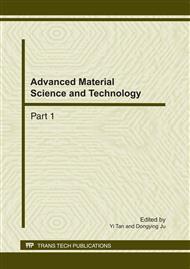[1]
Gibson LJ and Ashby MF. Cellular solids: structures and properties. Cambridge University Press; (1997).
Google Scholar
[2]
Sugimura Y., Meyer J., He M., Bart-Smith H., Grenstedt J. and Evans A. Acta Materialia, Vol. 45(1997), 5245~5259.
DOI: 10.1016/s1359-6454(97)00148-1
Google Scholar
[3]
Fusheng H, Zhengang Z. Journal of Materials Science, 1999, Vol. 34(2), 291~299.
Google Scholar
[4]
Andrews E., Sanders W., Gibson L.J. Materials Science and Engineering A, Vol. 270 (1999), 113~124.
Google Scholar
[5]
Idris M.I., Vodenitcharovaa T. and Hoffman M. Materials Science and Engineering A, Vol. 517(2009), 37~45.
Google Scholar
[6]
Ramamurty U. and Kumaran M. C. Acta Materialia, Vol. 52(2004), 181~189.
Google Scholar
[7]
Mohamad R. Said and Chee-Fai Tan. Chiang Mai Journal of Science, Vol. 35(2008) , 241~249.
Google Scholar
[8]
Yongliang Mu, and Guangchun Yao. Materials Science and Engineering A, Vol. 527(2010), 1117~1119.
Google Scholar
[9]
Edwin R, Venkitanarayanan P and Daniel B.S.S. Materials Science and Engineering A, Vol. 521(2009), 11~15.
Google Scholar
[10]
Gassa J. and Harwick W. Journal of Materials Science Letters, Vol. 20(2001), 1047~1048.
Google Scholar
[11]
Zhao H, I. Elnasri and S. Abdennadher. International Journal of Mechanical Science, Vol. 47(2005), 757~774.
Google Scholar
[12]
Tan P J, Reid S R, Harrigan J J , et al. Journal of the Mechanics and Physics of Solids, Vol. 53(2005), 2174~2205.
Google Scholar
[13]
Tan P J , Reid S R , Harrigan J J , et al. Journal of the Mechanics and Physics of Solids, Vol. 53(2005), 2206~2230.
Google Scholar
[14]
Mukai T., Miyoshi T., Nakano S., Somekawa H., Higashi K. Scripta Materialia. Vol. 54 (2006), 533~537.
DOI: 10.1016/j.scriptamat.2005.10.062
Google Scholar
[15]
Hall I W, Guden M and Yu C J. Scripta Materialia, 2000, 43(6): 515~521.
Google Scholar
[16]
Mukai T., Kanahashi H., Miyoshi T., Mabuchi M., Nieh T.G., Higashi K. Scripta Materialia. Vol. 40 (1999), 921~927.
DOI: 10.1016/s1359-6462(99)00038-x
Google Scholar
[17]
Dannemann K. and Lankford J. Materials Science and Engineering A, Vol. 293 (2000), 157~164.
Google Scholar
[18]
Kanahashi H., Mukai T., Yamada Y., Shinojima K., et al. Higashi. Mat. Sci. and Eng. A, Vol. 280 (2000), 349~353.
Google Scholar
[19]
Ruan D., Lu G., Chen F. L, Siores E. Composite Structures, Vol. 57(2002), 331~336.
Google Scholar
[20]
Hanssen A G, Langseth M and Hopperstad O S. International Journal of Mechanical Sciences, Vol. 43(2001), 153~176.
Google Scholar
[21]
Chen W G. International Journal of Solids and Structure, Vol. 38(2001), 7919~7944.
Google Scholar
[22]
Wang QC, Fan ZJ, Song HW and Gui LJ. International Journal of Crashworthiness, Vol. 10(2005), 535-543.
Google Scholar


